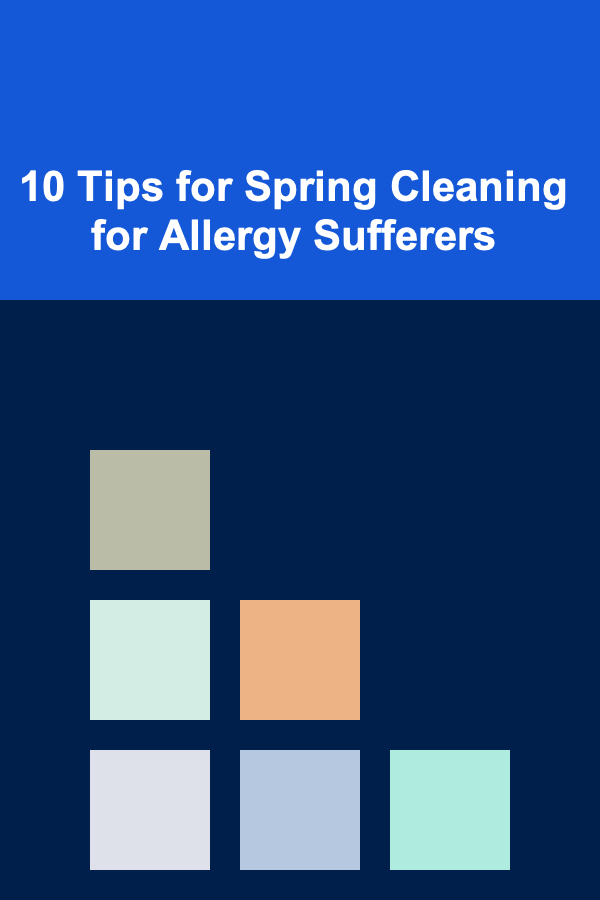
10 Tips for Spring Cleaning for Allergy Sufferers
ebook include PDF & Audio bundle (Micro Guide)
$12.99$6.99
Limited Time Offer! Order within the next:

Spring cleaning can be an exciting time to refresh your home and welcome the new season, but for allergy sufferers, it can also trigger discomfort with dust, pollen, mold, and other allergens. Proper spring cleaning is essential to ensure your home is not only sparkling clean but also free from allergens that can exacerbate seasonal allergies. In this article, we'll explore 10 effective tips for spring cleaning that can help allergy sufferers breathe easier and enjoy a healthier home.
Start with an Allergy-Friendly Plan
Before diving into your spring cleaning routine, it's essential to plan your approach to minimize exposure to allergens. Make a list of tasks that target key allergy hotspots, such as dust buildup, pet dander, and mold, which are common triggers for allergic reactions. Create a strategy that includes the following:
- Avoiding tasks that might stir up dust too much, such as vacuuming before dusting.
- Ensuring adequate ventilation during cleaning, particularly when using cleaning products that may contain chemicals.
- Using allergy-friendly cleaning products that are free of fragrances, harsh chemicals, and other irritants.
Having a clear plan will help you stay focused and tackle the cleaning process in a way that's gentle on your allergies.
Invest in a High-Efficiency Particulate Air (HEPA) Filter Vacuum Cleaner
Vacuuming is one of the most important tasks during spring cleaning, but regular vacuums often just stir up allergens like dust and pet dander, sending them into the air. To reduce your exposure, invest in a vacuum cleaner that's equipped with a HEPA (High-Efficiency Particulate Air) filter. HEPA vacuums are designed to trap small particles, including dust mites, pollen, and mold spores, preventing them from being released back into the air.
When vacuuming, pay special attention to high-traffic areas, rugs, carpets, upholstery, and beneath furniture, where dust can accumulate. HEPA vacuum cleaners help ensure that these particles are safely captured and don't trigger allergic reactions.
Dust with Microfiber Cloths
Traditional dusting methods, such as using feather dusters or cotton rags, can actually disperse dust and allergens into the air, making matters worse for allergy sufferers. Instead, opt for microfiber cloths, which are highly effective at trapping dust and other allergens. Microfiber cloths are designed to capture dust and hold onto it, preventing it from becoming airborne again.
Wipe down surfaces such as shelves, furniture, baseboards, and light fixtures to remove accumulated dust. Don't forget to clean electronic devices, as they tend to gather dust as well.
Wash Bedding and Curtains
Bedding, pillowcases, blankets, and curtains are all common places for allergens to accumulate. Dust mites, pet dander, and pollen can easily settle in these fabrics, triggering allergic reactions during sleep. To reduce allergens in your home:
- Wash your bedding weekly in hot water (at least 130°F or 54°C) to kill dust mites.
- Launder curtains and drapes, or consider switching to washable window treatments.
- For pillows, mattresses, and blankets, use allergen-proof covers to keep dust mites and other allergens from penetrating the fabric.
By regularly washing your textiles, you'll reduce your exposure to airborne allergens and improve your overall indoor air quality.
Change Air Filters in Heating and Cooling Systems
Your heating, ventilation, and air conditioning (HVAC) system plays a key role in filtering the air in your home. However, over time, air filters can become clogged with dust, pet dander, pollen, and other particles, causing them to release allergens back into the air. To maintain optimal air quality:
- Change air filters every 1 to 3 months, depending on the type of filter and usage.
- Choose filters rated for allergy sufferers (e.g., MERV 11 or higher).
- Consider investing in an air purifier with a HEPA filter to help reduce airborne allergens further.
By maintaining your HVAC system and using high-quality air filters, you can significantly improve the air quality in your home and reduce allergy flare-ups.
Clean Your Home's Air Ducts
In addition to changing the air filters, cleaning the air ducts in your home can help remove dust, mold, and other allergens that may have accumulated over time. Air ducts can act as a storage space for allergens, which are then spread throughout the house when the HVAC system runs.
If you have a central heating and cooling system, it's advisable to have your ducts professionally cleaned every few years, especially if you've experienced issues with mold, dust, or pet dander buildup.
Tackle Mold in Damp Areas
Mold is a common trigger for allergies and asthma, and it thrives in damp, humid environments. During spring cleaning, pay special attention to areas that are prone to mold growth, such as bathrooms, kitchens, and basements. Take these steps to reduce mold in your home:
- Clean bathroom tiles, grout, and caulking with an antimicrobial cleaner or a mixture of vinegar and water to kill mold spores.
- Use a dehumidifier in damp areas to reduce humidity levels and prevent mold growth.
- Replace old, moldy shower curtains or liners, or wash them thoroughly to remove any buildup.
By addressing mold growth in your home, you'll prevent it from spreading and triggering allergic reactions.
Minimize Outdoor Allergens by Cleaning Windows and Doors
Pollen is a major allergen in the spring, and it can easily enter your home through open windows and doors. Before you open windows to enjoy the fresh air, make sure they are clean and that screens are free of pollen buildup. Follow these tips:
- Wash window screens using a hose or vacuum them to remove any pollen.
- Wipe down windowsills and window panes to remove any trapped dust and pollen.
- Consider keeping windows closed on high-pollen days to minimize exposure.
By taking these simple steps, you can limit the amount of outdoor allergens entering your home, which will help reduce allergy flare-ups.
Use Allergen-Free Cleaning Products
Many cleaning products contain chemicals, fragrances, and other irritants that can worsen allergies. To keep your home allergen-free, opt for cleaning products labeled as hypoallergenic or free from harsh chemicals. Additionally, you can make your own natural cleaning solutions using ingredients like vinegar, baking soda, and lemon juice.
Some tips for using allergy-friendly cleaning products include:
- Avoid using heavily scented cleaners that can irritate sensitive respiratory systems.
- Choose fragrance-free laundry detergents and fabric softeners to wash your clothes and bedding.
- Use all-natural disinfectants or essential oils for a fresh, non-chemical scent.
Using allergen-free cleaning products will help minimize exposure to potential irritants while ensuring your home is clean and safe.
Maintain a Regular Cleaning Schedule
To ensure your home remains allergen-free, it's important to maintain a regular cleaning routine throughout the year. Spring cleaning is just the beginning, but consistent cleaning can help you stay ahead of allergens that build up over time.
- Set aside time each week to vacuum and dust your home using allergy-friendly tools and techniques.
- Clean high-traffic areas, such as entryways and living rooms, more frequently to reduce the accumulation of dirt and allergens.
- Make a habit of washing bedding, curtains, and textiles regularly to keep allergens at bay.
By staying consistent with your cleaning routine, you'll be able to create an allergy-friendly environment that promotes better health and comfort year-round.
Conclusion
Spring cleaning is a time-honored tradition that can bring a fresh start to your home, but for allergy sufferers, it's important to approach cleaning with care to minimize exposure to allergens. By following these 10 tips---ranging from using HEPA filters and microfiber cloths to addressing mold and keeping allergens out of your home---you can create a clean and healthy environment that minimizes allergy symptoms. With a little planning and effort, spring cleaning can become a revitalizing experience that leaves your home sparkling and allergen-free.
Reading More From Our Other Websites
- [Home Holiday Decoration 101] How to Turn Your Stairs into a Holiday Showcase with Simple Decor
- [Home Staging 101] How to Use Mirrors in Home Staging to Create More Light
- [Organization Tip 101] How to Archive Family Heirlooms for Future Generations
- [Personal Care Tips 101] How to Style a Pompadour with Hair Gel
- [Home Security 101] How to Secure Your Home for Elderly Residents
- [Home Staging 101] How to Elevate Your Hallway Staging: Beyond the Basics for a Grand Entrance
- [Whitewater Rafting Tip 101] Gear Up for Fun: Essential Gear and Hacks for a Stress‑Free Rafting Experience
- [Rock Climbing Tip 101] Avoiding Bruises: Practical Strategies for Falling Safely at Home and Outdoors
- [Personal Care Tips 101] How to Get Maximum Volume Without Sticky Hair Using Hair Mousse
- [Organization Tip 101] What Are the Key Principles of Sustainable Home Organization?

How to Plan a Memorable Home Cocktail Party
Read More
How to Set Up a Home Scavenger Hunt for Kids
Read More
Recruiter's Handbook: Best Practices for Building Strong Candidate Pipelines
Read More
Choosing the Best Training Regimen for Extreme Sports
Read More
How to Master Your TV Show Binge-Watching To-Do List
Read More10 Tips for Optimizing Your Resume and Interview Expense Tracker
Read MoreOther Products

How to Plan a Memorable Home Cocktail Party
Read More
How to Set Up a Home Scavenger Hunt for Kids
Read More
Recruiter's Handbook: Best Practices for Building Strong Candidate Pipelines
Read More
Choosing the Best Training Regimen for Extreme Sports
Read More